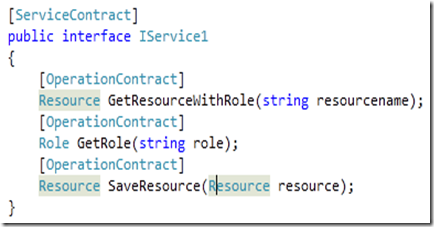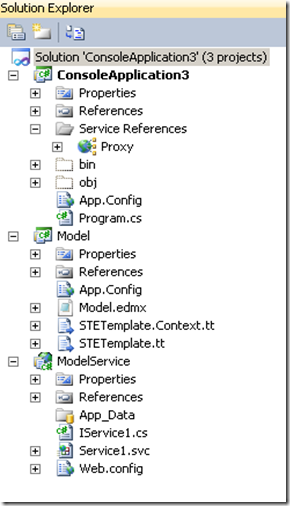Using Self Tracking Entity to retrieve and update
In this tutorial I will explain how to use Self Tracking Entity to retrieve entities from a WCF service, modify the object graph on the client side and then send those changes back to the server in a clean way.
Suppose we have Resource and Roles with many-to-many relationship as shown below.
2. Create a class library project and import the above table structure into an Entity Data Model as shown below.
Entity Framework will see the link containing primary keys from both tables and will model it as many-to-many association.
For WCF scenario it is recommended to use STE template for code generation for your entities. Self tracking entity implements IObjectWithChangeTracker which allows the entities to keep track of its own changes. For instance if you modified scalar properties, reference properties or collections, the change tracker would keep a log of what’s changed. This is especially useful for WCF clients where there is no concept of an ObjectContext on the client side and we need some mechanism to keep track of the changes client is making. Once those changes are captured, we can send the entities to the server and replay those changes on the ObjectContext using ApplyChanges method.
To generate Self Tracking Entities for your model, right click anywhere on the model, select Add Code Generation Item and choose Self Tracking Entity template. Build the project and make sure there are no errors.
3. Add a new WCF service application and reference the class library project which contains your model and self tracking entities. Add reference to System.Data.Entity.
4. Create a service interface and its implementation with three methods. First method will return a Resource given a resourcename along with the roles associated to that resource. Second method should return a role give a role name. Last method would take modified object graph for resource and save it to the database. Code below shows the interface and its implementation.
In the Service1 class, to save the resource, we use ApplyChanges method to attach the entity. ApplyChanges is a special method which looks a the change track to see what has changed and replays those changes on the object context. In our case we have added an existing role to a resource so we should see a new entry created in REsourceRole table.
5. Create a console application that will serve as a client to our WCF service. Add reference to our class library project that contains our self tracking entities. Next start the instance of the service created earlier so you can add service reference in our client project. It is important to explain at this point that when you add WCF service reference, you will not see entity classes generated on the client side. This is because the service returns entities whose reference is already available when we added reference to the class library project. This means that we are basically sharing the same code for entities on the server and client. If you did not add reference to the class library project and let service reference generate its own classes then you would end up with basic entities which have no ability to keep track of its changes.
On the Program.cs class add the following code which basically retrieves a a given resource, retrieves a role and then adds that role to the resource’s roles collection and sends the changes to the server.
The complete structure of my solution contains 3 projects, a class library project containing my model and Self Tracking Entities, a service that exposes my entities and a console application that consumes the serve. Figure below shows the screen shot from Solution explorer





